Abstract
The endotoxin concentration in air was measured in farms where 11 farmers had experienced febrile reactions or allergic alveolitis and in a random sample of farms with 17 symptomless farmers. Samples were obtained during normal dairy farming in eight reference farms (background samples) and in all farms during the handling of material which had probably caused symptoms or disease or, in reference farms, maximal spore exposure (worst case samples). In addition, parallel samplers were used in reference farms, one with a cyclone (5 microns cutoff) and one without, to measure the dust and endotoxin concentrations in the respirable fraction and total dust. The endotoxin worst case values varied from less than 0.01 to greater than 50 micrograms/m3 in symptom farms (median 6.4 micrograms/m3, geometric mean 2.2 micrograms/m3) and from less than 0.01 to greater than 50 micrograms/m3 in reference farms (median 42 micrograms/m3, geometric mean 29 micrograms/m3). This difference was not statistically significant. The background values in reference farms were 1.3 (median) and 0.4 (geometric mean) micrograms/m3. The differences between samples with and without cyclone and between background and worst case samples were statistically significant (p less than 0.02). About 75% of the activity was found in the non-respirable fraction. No correlation was found between exposure to endotoxin and symptoms in farmers. There were weak, but statistically significant, correlations between endotoxin concentrations and total spore count or dust concentrations. The surprisingly high endotoxin values in the respirable fraction of air from environments which apparently did not cause symptoms raises the concern that the Limulus amebocyte assay might be sensitive to other components in the dust rather than endotoxin.
Full text
PDF




Selected References
These references are in PubMed. This may not be the complete list of references from this article.
- Cavagna G., Foà V., Vigliani E. C. Effects in man and rabbits of inhalation of cotton dust or extracts and purified endotoxins. Br J Ind Med. 1969 Oct;26(4):314–321. doi: 10.1136/oem.26.4.314. [DOI] [PMC free article] [PubMed] [Google Scholar]
- Clark S., Rylander R., Larsson L. Airborne bacteria, endotoxin and fungi in dust in poultry and swine confinement buildings. Am Ind Hyg Assoc J. 1983 Jul;44(7):537–541. doi: 10.1080/15298668391405265. [DOI] [PubMed] [Google Scholar]
- Dinarello C. A. Molecular mechanisms in endotoxin fever. Agents Actions. 1983 Aug;13(5-6):470–486. doi: 10.1007/BF02176419. [DOI] [PubMed] [Google Scholar]
- Haglind P., Rylander R. Exposure to cotton dust in an experimental cardroom. Br J Ind Med. 1984 Aug;41(3):340–345. doi: 10.1136/oem.41.3.340. [DOI] [PMC free article] [PubMed] [Google Scholar]
- LEVIN J., BANG F. B. THE ROLE OF ENDOTOXIN IN THE EXTRACELLULAR COAGULATION OF LIMULUS BLOOD. Bull Johns Hopkins Hosp. 1964 Sep;115:265–274. [PubMed] [Google Scholar]
- Maitra S. K., Nachum R., Pearson F. C. Establishment of beta-hydroxy fatty acids as chemical marker molecules for bacterial endotoxin by gas chromatography-mass spectrometry. Appl Environ Microbiol. 1986 Sep;52(3):510–514. doi: 10.1128/aem.52.3.510-514.1986. [DOI] [PMC free article] [PubMed] [Google Scholar]
- Malmberg P., Rask-Andersen A., Höglund S., Kolmodin-Hedman B., Read Guernsey J. Incidence of organic dust toxic syndrome and allergic alveolitis in Swedish farmers. Int Arch Allergy Appl Immunol. 1988;87(1):47–54. doi: 10.1159/000234647. [DOI] [PubMed] [Google Scholar]
- Mikami T., Nagase T., Matsumoto, Suzuki S., Suzuki M. Gelatin of Limulus amoebocyte lysate by simple polysaccharides. Microbiol Immunol. 1982;26(5):403–409. doi: 10.1111/j.1348-0421.1982.tb00190.x. [DOI] [PubMed] [Google Scholar]
- Palmgren U., Ström G., Blomquist G., Malmberg P. Collection of airborne micro-organisms on Nuclepore filters, estimation and analysis--CAMNEA method. J Appl Bacteriol. 1986 Nov;61(5):401–406. doi: 10.1111/j.1365-2672.1986.tb04303.x. [DOI] [PubMed] [Google Scholar]
- Pearson F. C., Bohon J., Lee W., Bruszer G., Sagona M., Jakubowski G., Dawe R., Morrison D., Dinarello C. Characterization of Limulus amoebocyte lysate-reactive material from hollow-fiber dialyzers. Appl Environ Microbiol. 1984 Dec;48(6):1189–1196. doi: 10.1128/aem.48.6.1189-1196.1984. [DOI] [PMC free article] [PubMed] [Google Scholar]
- Rylander R., Morey P. Airborne endotoxin in industries processing vegetable fibers. Am Ind Hyg Assoc J. 1982 Nov;43(11):811–812. doi: 10.1080/15298668291410611. [DOI] [PubMed] [Google Scholar]
- Sharpe A. N., Jackson A. K. Stomaching: a new concept in bacteriological sample preparation. Appl Microbiol. 1972 Aug;24(2):175–178. doi: 10.1128/am.24.2.175-178.1972. [DOI] [PMC free article] [PubMed] [Google Scholar]
- Wildfeuer A., Heymer B., Schleifer K. H., Haferkamp O. Investigations on the specificity of the Limulus test for the detection of endotoxin. Appl Microbiol. 1974 Nov;28(5):867–871. doi: 10.1128/am.28.5.867-871.1974. [DOI] [PMC free article] [PubMed] [Google Scholar]


